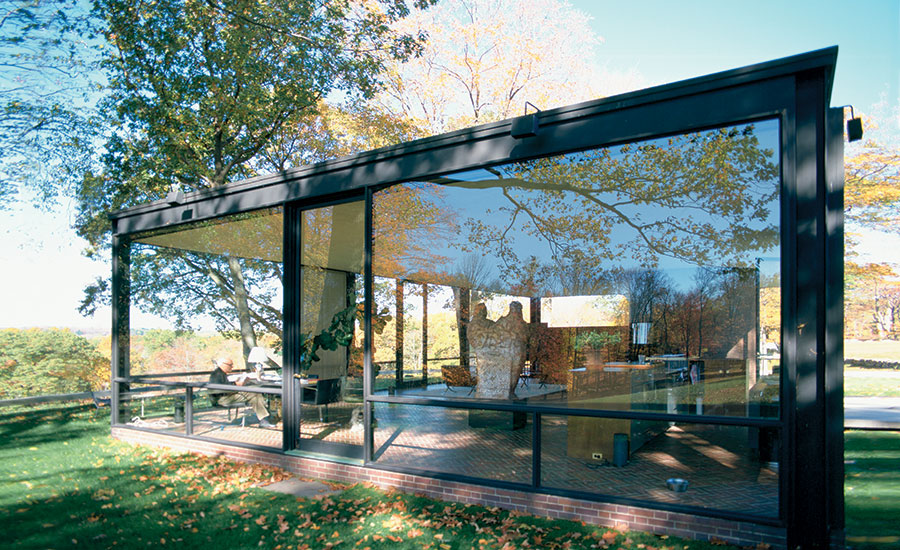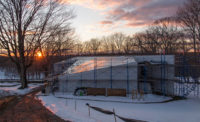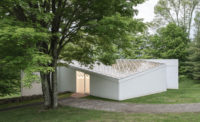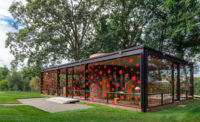The quixotic personality of Philip Johnson has fascinated and frustrated critics for over half a century. How to approach the curator who heretically transformed the Modern Movement into a stylistic category by way of the famous exhibition on the International Style and book of 1932; who openly supported fascist movements in the years leading up to World War II; who switched careers by becoming a Harvard-trained architect just before the war; who was a follower of and collaborator with Mies van der Rohe in the 1950s; who then became an adopter of Postmodernism by the late 1970s and who reigned as the premier architecture broker of New York from his seat at the Four Seasons restaurant for nearly half a century?
Is it all a delightful masquerade, a firefly dancing on the surface of life and art for half a century? Is it a series of deeply felt attempts at engaging and transforming the discipline that had, to quote architectural historian Paolo Portoghesi, “too many inhibitions”? Is there a hidden sense of inadequacy that drives a designer to more and more outlandish stylistic experiments? Was it, simply, a lust for power, whether political or architectural? Certainly this is a subject that calls for an analysis beyond the usual categories of art history, architectural criticism, and political commentary.
Johnson’s first major completed work, the Glass House in New Canaan, Connecticut (1949), provides an opportunity to go beyond the usual architectural analysis to a psychological one, as Adele Tutter does in Dream House: An Intimate Portrait of the Philip Johnson Glass House (2016), ideas on which I am tempted to expand.
As an art historian and architect, Johnson naturally was quick to provide his own arthistorical explanation: just a year after the house’s completion, he wrote about its precedents in Architectural Review, using captioned images. They included a site plan for a farm village and for Mies van der Rohe’s Chicago IIT campus of 1939, as well as the “asymmetric sliding rectangles” of Dutch de Stijl, the views of the Acropolis drawn by Auguste Choisy in 1898 (and pointed out by Le Corbusier in Vers Une Architecture). With his design, Johnson moved from an original scheme of a brick house with semicircular arches—à la John Soane (which ended up as plastered coves inside his Brick Guest House of 1952) to a pavilion inspired by Karl-Friedrich Schinkel’s Casino in Glienecke Park near Potsdam of around 1830. Only after Johnson had viewed the model of Mies’s own glass house for Dr. Edith Farnsworth (1951) in Plano, Illinois, did his house suddenly emerge fully fledged as glass.
Still, the house is a deliberate transformation, rather than imitation, of Mies’s aesthetic. It is no longer raised on stilts, as is the Farnsworth, but seated firmly on a farmhouse brick foundation; no longer a horizontal space reaching out to infinity between two floating planes but a closed box, with a roof and corners, approaching the diagram of a solid Schinkelesque pavilion. And no longer is it an optimistic vision of a horizontal universal space but one rooted in the landscape by the cylinder containing a fireplace and bathroom—a “post-modern” house avant la lettre.
There has always been a suspicion that so complex a figure as Johnson demands yet a different kind of analytical approach to this work. Tutter, a psychoanalyst, interprets the house as a form of dream. She admits the risk of seating the architecture on the couch as a substitute for its author, but for her, the house is a repository packed with architectural signs of envy, a sense of inadequacy, deferral, and the burial of memory. Starting from what Johnson called the house and its supporting pavilions—his “diary”—whose construction continued until his death in 2005, Tutter investigates the letters, recorded conversations, and a wealth of archival material, not to mention the rich art-historical and critical record. Out of this exploration, she has constructed a fascinating and often penetrating narrative that allows us to see Johnson’s Glass House as a deeply layered expression of his own psyche.
The result illuminates not only the personality—prone to depression, self-doubt, and self-criticism–but Johnson’s intense outward self-confidence and brilliant insight, as well as hitherto hidden or repressed sources for the design of the house. In this vein, Tutter uncovers a possible source for the cylindrical chimney: the Avon Old Farms School in Connecticut, with its round brick water tower (1918–27) designed by a cousin of Johnson’s mother, Theodate Pope Riddle. Tutter senses a psychological significance to Johnson’s silence about this appropriation as possibly coming from envy on his and his mother’s part—and maybe at the same time from feelings of inadequacy Johnson had in following the cousin’s architectural career.
But Tutter asks whether deeper feelings are at work. She points to Johnson’s installation of a painting as a clue, perhaps, of Johnson’s own anxieties over his 1930s sympathies for Nazism. The painting, attributed to Poussin, the Burial of Phocion (1648), is displayed on an easel in the living area as if to connect the house to the picturesque landscape outside. But it depicts a 4th-century-B.C. Athenian statesman convicted of treason for his relations with a foreign dictator. She considers Johnson’s passion for Poussin to stem from this choice of Phocion as the subject of the painting.
Here we might go even further than Tutter and follow Freud in his own thoughts during the First World War, specifically in his reflections on the uncanny. In a paper written in 1919, Freud linked the sensation of the uncanny (in German, unheimlich—literally “unhomelike”) to, among other things, a kind of fearfulness that emerges with the reappearance of something that suddenly surfaces after long repression. It can be a sharp shock of unwelcome memory.
Freud links this sensation of dread and horror to the idea of the house and its heimlich (homey) interior, which through unexpected changes is transformed into an unheimlich space. Returning to the Glass House’s cylindrical fireplace and bathroom on a platform, we see, as Johnson wrote in a 1950 essay, that they did not derive from Mies but rather from a “burned-out wooden village” he had once seen, “where nothing was left but the foundations and the chimneys of brick.” He did not mention that he had encountered this scene when reporting from the Polish front during the German invasion of 1939—a moment in his former attraction to Hitler’s Reich that has famously been exhumed by writers from Franz Schulze to Marc Wortman. In that context, we might see Johnson’s house as a Polish farmhouse “purified” by the fire of war of everything but its architectural “essence,” enclosed in a glass box to preserve it intact on a pastoral site in Connecticut, thus apparently exorcising the horror.
The “uncanny,” as Freud emphasizes, however, can also be subtle and less striking—something, as he notes, like the fleeting reflection of oneself in a mirror, a sudden revelation of one’s own unwelcome image. In the case of the house of glass, perhaps its uncanniness derives less from its mimicking of the destroyed village than from its dually reflective and transparent surfaces, whose phantasmagoric effects create a montage of interior and exterior, of objects and sky. Johnson seemed to revel in these unhomelike appearances, through which he was at once present and absent in his own dwelling. Some especially revealing photographs include Johnson half hidden by shadows as he sits or stands inside the house, emerging as if from the reflections themselves—half real, half ghost, a “presence” merged with the glass, dissolving himself as a subject within his unsettling, uncanny object.





Post a comment to this article
Report Abusive Comment